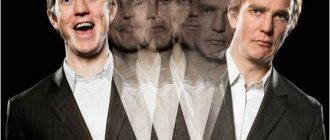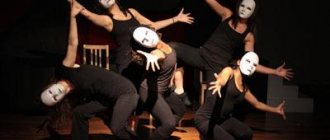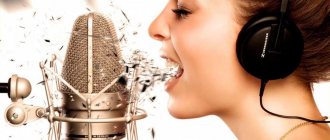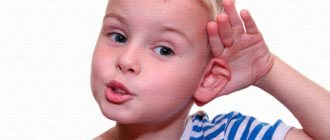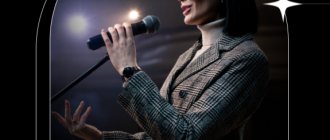Developed facial expressions are a useful quality not only for a theater artist, but also for any person who, due to duty or hobby, often has to perform in public. Mimic expressiveness plays no less a role than speech, since it reflects the emotional life of the artist during the performance and emphasizes the meaning put into the words.
In everyday life, facial expressions are a means of non-verbal communication between people: it is through them that we understand what emotions a person experiences before he begins to speak. The instant and uncontrollable facial reaction of the facial muscles to any event makes facial expressions the most accurate indicator of a person’s mood and his attitude towards something. However, future artists often require additional development of facial expressions.
“The face is the mirror of the soul.” Cicero
If in life facial expressions are our constant companion, then in imitation of life, which is almost any public performance, the absence or lack of facial expressions is the first sign of falsehood.
Imagine Romeo declaring his love with a straight face, or Hamlet during his famous monologue “To be or not to be” with a facial expression a la “Semyon Altov”. Any tragedy with such a game is doomed to turn into a comedy, and vice versa - a comedy risks becoming tragically boring. That is why the facial expressions of actors require development, and this is given the same great attention as the development of correct speech.
How to develop facial expressions
- Do facial expressions age you?
- Facial exercise
- Studying emotions
- Guessing game
- Learn to do what you don't know how to do
- Bad facial habits
Facial expressions are a powerful tool for expressing emotions and feelings, which can be more eloquent than any words.
It is not for nothing that there is a separate genre of theatrical art - pantomime. A mime can make audiences cry and laugh by acting out the performance with his face. Imagine how impoverished communication will be if you deprive it of additional ways of conveying your internal state - intonation, gestures and facial expressions. There are many professions for which the ability to control facial expressions is very important. This is both a vivid expression of emotions, and vice versa - the ability not to reveal one’s feelings. Actors, teachers, managers, diplomats, businessmen, TV presenters... But not only for work you need to know how to train facial expressions - everyone should be able to convey their feelings beautifully and reliably. In parallel with facial expressions, it is necessary to develop the speech apparatus - these two mechanisms are inextricably linked with each other. For example, there is a therapeutic complex of facial exercises for children with dysarthria - a disorder of pronunciation function. There is a “mutual guarantee” between speech and facial expressions: the clearer the speech, the better developed the facial muscles and vice versa.
But before we find out how to develop facial expressions, let's deal with an issue that worries many.
How to look good and beautiful in photographs: poses
Learn to change your emotions
Various poses in the studio
Poses for pregnant women
Options for lovers
Do facial expressions age you?
There is an opinion that lively facial expressions quickly age a person: where folds often appear, deep wrinkles form over time. Is it so?
In order not to be unfounded, let's compare film actors known for their facial skills. Jim Carrey comes to mind first. He is in his early 50s and already has noticeable wrinkles, especially around the eyes. The actor himself admits that his career as an actor with the most expressive face gave him wrinkles. But at the same time, Kerry never had plastic surgery or Botox injections - since they make facial expressions more constrained, this is strictly contraindicated for a movie star. In order to slow down the aging process, Kerry uses creams.
Jackie Chan is another person with rich facial expressions who is always smiling. He is a little over 60 years old, but he looks great. Of course, he also has facial wrinkles, but throughout his life Jackie has only performed operations related to injuries - no plastic surgery.
The ever-present Johnny Depp is also slightly over 50, but it’s hard to believe - it seems that he is at most 40. But there is one secret - Captain Sparrow had plastic surgery: a facelift, eyebrow lifting and blepharoplasty (around the eyes).
But the actor famous for his almost complete lack of facial expressions - Keanu Reeves - does not age at all. He is the same age as Depp and Kerry, but at the same time he looks 30. They say that Neo does not disdain Botox, but the actor himself does not admit it. His main acting tool is his eyes.
Indeed, certain facial habits leave an imprint on the face - but this happens within the allotted time, when a person develops natural wrinkles, and not earlier. And what kind of wrinkles they will be is up to you to choose: either deep furrows from a gloomy frowning forehead, or charming rays around the eyes from laughter. And don’t forget that actors known for their ability to make faces have been doing this professionally all their lives. They filmed millions of takes and grimaced much more than a person would need in everyday life. Imagine Jim Carrey in his office. Did you laugh?
Those who are afraid of losing their youth need to remember additional factors - heredity, skin type, exposure to the sun, facial care. Massage, anti-aging treatments, creams and oils will help you not be afraid of the appearance of early wrinkles.
Correction of the consequences of facial activity
Correction of the consequences of facial activity (photo: @roseinc) The very first to appear are facial wrinkles around the eyes (“crow’s feet”), on the forehead and between the eyebrows, as well as nasolabial folds. It is impossible to completely avoid their occurrence, but it is quite possible to slow down this process.
- To prevent the early appearance of expression lines, you can use home care products with powerful ingredients. As well as various treatments, such as facial massage and deep cleansing, that improve skin condition.
- If expression lines have already appeared, botulinum therapy (Botox) is used to block the most active muscles. It relieves hypertonicity, which means that you gradually lose the habit of frowning, tucking your chin and squinting. Over time, the dosage of botulinum toxins will decrease and the intervals between procedures will increase.
- In addition to botulinum therapy, expression wrinkles can also be corrected using hardware techniques, such as laser resurfacing or phototherapy. In this case, the potential of skin cells to renew is stimulated and wrinkles become less noticeable.
Alternative to injections and plastic surgery: 15-minute facial massage “Kobido” Read
Facial exercise
In order to develop your facial expressions, you first need to make your face more mobile and loosen your facial muscles.
Athletes do a warm-up before training - let’s do this too. You need to stand in front of the mirror, put your hair in a ponytail, and pin up your bangs. The entire face should be visible. Start vigorously moving different parts of your face, trying to develop as much amplitude as possible. Here are examples of such movements:
- Raise and lower your eyebrows;
- Open and close your mouth wide;
- Smile as widely as possible without exposing your teeth, then sharply fold your lips into a bow or “duck”;
- Open your eyes wide and squint.
It is important that when exercising on a certain part of the face, the rest are not involved. At first, this can be difficult - some muscles “pull” others along with them, and together with your eyebrows, for example, you begin to reflexively raise your lips.
Which side to turn
We will leave the frontal photo for important documents. Does everyone remember how “beautiful” we look in our passports? So let's not repeat this mistake in those photographs where we want to turn out beautiful.
Most of all, girls want to look natural, but fake photos turn out, at best, like those in a passport. We are not professional models.
Models used trial and error to find the ideal facial position in the photo. The head should be turned approximately 45 degrees towards the photographer. Something like this:
Of course, you don’t need to walk in front of the photographer with a protractor, but it won’t hurt to rehearse in front of the mirror. Or take a selfie.
I especially recommend taking selfies for guys, this will save them from looking in the mirror for a long time, and the resulting photos are easy to look at and analyze.
The same applies to the whole body. Yes, and it would be strange to stand directly in front of the photographer and look somewhere to the side. So the whole pose is not straight, but slightly turned to the side.
This, by the way, is a standard pose for photos on the red carpet. And if the most popular people in the world have been using this trick for decades, why shouldn't we?
Studying emotions
As you remember, we will need the development of facial expressions primarily in order to colorfully convey emotions. Therefore, you need to learn the appropriate facial expression and learn to apply this skill in communication. Many people do not know how to convey emotions “to order”: you ask them to portray anger, but it turns out to be a comical mask. This is because they don’t know what they look like from the outside. We will eradicate this problem with the help of the following exercise.
Stand in front of the mirror and try to portray the following emotions:
If you are not satisfied with the result, look at the actors' faces in certain situations and try to imitate their expressions. If you can’t evaluate the results of your work in the mirror, take a selfie; it’s easier to draw objective conclusions from a photograph.
At sessions, the fashion model is obliged to depict all the feelings and states that the photographer gives her: “Give me some tenderness! Innocence! Aggression! You saw a kitten! They gave you a car!” And she must perform all this no worse than a Hollywood film star.
Many people think that models only need beauty and figure, but the ability to be photogenic and control your face plays a very important role in this profession. Try to be a fashion model and portray all the emotions and reactions that come to your mind.
How to look good and beautiful in a passport photo?
There is a joke: “If you look like the photo in your passport, it’s time for you to go on vacation!”
Very often people, especially women, are dissatisfied with their image in their passport. A passport photo is not the place where you can experiment with angles and a smile. Here you can see both facial asymmetry and contour imperfections. However, there are small tricks here too:
- Facial tone . Create an even, natural tone using cosmetics. Conceal the circles under the eyes, remove pimples and other imperfections with concealer. Set your makeup with powder to avoid shine.
- Eyes . You should not do provocative makeup. Beautiful eyelashes and neat arrows will sufficiently emphasize the eyes.
- Lipstick . Choose the most natural tone; do not paint your lips with a bright color. Or leave them without makeup at all.
- Hair . If your hairstyle is sloppy, the photo cannot be saved. Hair should be clean, neatly styled, without overgrown roots.
Bad facial habits
To have beautiful and expressive facial expressions, you need to get rid of habits that spoil your facial expression and cause early wrinkles. Many of us squint, wince, grimace and frown without even realizing how much it harms us. If you know such habits, control them. And in order not to relax, periodically squint or wince in the mirror - see how ugly it is, and you will immediately have an incentive to get rid of these grimaces. If you constantly forget about self-control, ask someone close to you to remind you. Mothers deal with this best - they are more concerned than anyone that their children be beautiful and charming.
*** Everyone has facial expressions - they are embedded in the brain in childhood, when babies look at their parents and copy their facial expressions. But uncontrolled facial expressions are like an ill-mannered person - they will always find where to make trouble. You can compare it to a horse riding a rider - instead of making life easier, uncontrolled facial expressions complicate it. They say about such people: everything is written on his forehead. And he would like to hide his feelings, but he cannot.
Its role should not be belittled - just the ability to correctly use facial expressions can significantly change a person’s fate. And you can start learning this skill at any time, regardless of age.
PS Find out “What is artistry and how to develop it”
If you find an error, please select a piece of text and press Ctrl+Enter.
Why is it important to know how to pose?
Many people refuse to take photos, arguing that they are “unphotogenic.” Do you know why this is a failed strategy? Because everyone has cameras today! Smartphones, tablets, even some watches.
You can always refuse, but with such a dominance of cameras, you can earn quite a bit of paranoia. And still get your pictures from time to time, for example, in a company.
It’s much calmer for the psyche to spend half an hour reading this material, rehearsing in the mirror and never again being afraid of turning out badly. There is no way to avoid photos. It's up to you to decide whether these will be good photos or a whole folder of horror stories for your grandchildren.
How do emotions show on the face?
The psychology of human behavior is limitless. To fully study the secrets of facial expressions as one of its sections, it will take more than one year. Meanwhile, you can learn to understand your interlocutor by a glance or a hidden grin if you know about some nuances.
Firstly, the key to a correct understanding of what a person would like to say is an objective assessment of everything he reproduces, taking into account the relationship between speech and facial expressions. Secondly, people are able to express emotions that arise in the soul in two ways:
This means that if the partner wants not to reveal his true attitude to the information being communicated, he can limit himself to the simplest hint. But more often than not, this method is more misleading than effective.
How to determine the truth of information by facial expressions?
Before saying something, in most cases a person thinks about his words and tries to keep his facial expressions under control as much as possible. At the same time, it can be extremely difficult for the interlocutor to keep track of several reactions at once. Psychology will come to the rescue, teaching you how to properly develop the ability of facial “language” or identify a sincere attitude towards something by facial expressions.
Reactions that appear spontaneously or involuntarily in the interlocutor can be correctly read only if there is a long-term relationship with a partner. If you do not take this point into account, there will always be a possibility of critical self-deception in the process of deep recognition of your partner.
It is not difficult to determine the degree of personal expression from the facial expression of a human face, but it is extremely important to take into account many associated factors. It turns out that women have a much harder time managing their emotions than men. It is difficult for representatives of the fair sex to hide their existing experiences, so their face more clearly reveals its owner in a given situation. In addition to gender, other factors also play a role in the success of withholding information:
- temperament (it is easier for a phlegmatic person to protect his feelings from prying eyes than, for example, for a choleric person);
- additional related circumstances;
- experience of the receiving party.
Tricks from fitness blogs
A few words about popular blocks with photos. For example, fitness models. Does everyone understand that these beautiful girls don’t look as perfect as in the photo?
It's not just about Photoshop, although the most illiterate people also turn to it. It's all about the pose, angle, lighting and so on. Tighten your stomach, wear pants with a higher waist, choose good lighting for yourself.
Anyone with a more or less standard figure can look like a blogger. In what ways?
Head
The head is slightly sideways to the photographer, the ideal angle is 45 degrees.
Lifehack to remove excess chins and emphasize your neck. We stretch our neck and slightly lower our chin. It is better to rehearse your smile in advance in the mirror. Such a slight half-smile, in the photo - example above, right image. Always looks great!
Due to the natural asymmetry of the face, it is better to turn around in the mirror in advance and choose a more attractive side.
Hands
Oddly placed hands can ruin any photo. How to put your hands?
- In your pockets. Remember that your elbows should be behind your body.
- Something to hold. Bag, coffee, accessory. And the second hand in your pocket or on your belt. Elbows behind the body!
- On the belt. But! First, elbows behind the body. And, secondly, one hand is on the belt, and the other is somehow different. Stretched out, with coffee... but not waist-length. The exception is photos for professional clothing models, but we’re all amateurs, aren’t we?
- One arm is bent below the chest, the other to the chin or extended.
- Hands together, as if we are about to clap our hands.
You could write a whole book on how to place your hands. But in general, you need to look at all your fantasies in the mirror, choose the ones you need and then listen to the experience and trained eye of the photographer.
Legs
The universal rule is that one leg is slightly bent and definitely not at the same level as the other. It is better if the legs do not overlap each other.
Let's leave complex figures to professional models! I recommend transferring your entire body weight to one leg, and to the one behind you. About standing poses you can read:
How to learn to understand facial gestures?
Facial expression, as psychology says, is predetermined by the influence of experienced feelings, which provoke controlled contractions and relaxations of muscles. Many people want to master the ability to control their emotions by performing special facial exercises. However, all the measures taken to teach the subtleties of facial expressions will not be successful if you do not know about other important points.
For example, facial symmetry in displaying feelings helps to recognize a lie much faster. In addition, lips can give away a person’s desire to disguise.
For example, increased facial expressions in the mouth area allow us to conclude that the speaker is worried about something. Lips curved in one direction indicate a skeptical or mocking attitude towards what is happening.
More than speech. How to control facial expressions, gestures and intonation
Chapter 1. A brief excursion into the psychology of gestures
The hand is the soul of a gesture. The brush calls, beckons, invites, repels, gives, takes, reproaches, tells, caresses, punishes, asks, sees off...
Rudolf Slavsky, Soviet clown, artist and circus director. The art of pantomime
We begin our research with a small theoretical block. Communication in modern psychology is represented by two groups: verbal and nonverbal means.
In the verbal sphere, information is transmitted using words and special phonetic signs. This is what we say, hear, write, read and think directly or in some symbolic form. Oral speech is original. Written or graphically designed is secondary. Their literary form is distinguished by the presence of stable norms and rules; it is understood as exemplary. Non-literary is dialects, dialects and vernacular.
The nonverbal sphere is communication interaction between people, realized without the help of words. In this case, the human body becomes the instrument of communication. The following means and methods of transmitting information are distinguished:
• pantomime - general motor skills of the body (body position in space, changes in the mise-en-scène of communication and the way a person moves - gait, posture, postures);
• gestures - the most informative part: gestures. Most often these are interpretations of movements of the head and hands;
• facial expressions - movements of the facial muscles that express the state of mind and reflect feelings. There are six basic emotional states: anger, joy, fear, sadness, surprise and disgust. The main information load is carried by eyebrows and lips, the shape and expression of the eyes. This also includes the direction of gaze, duration and frequency of blinking;
• prosody (from the Greek prosoiclia
- “stress”, “chorus”) - intonation and phonation characteristics: para-linguistic (sound range, voice timbre, speech rate and logical stress), as well as extralinguistic components (pausing, coughing, laughter, sighs);
• takeshiku (from Latin taktus
- “touch”, “feeling”) - dynamic touches in the process of communication. Particularly noteworthy are handshakes (they are divided into three types: dominant, submissive and equal), kisses, pats, stroking and pushing;
• proxemics (from English proximity
- “proximity”), a term by American anthropologist Edward Hall, denoting the zones of the most effective and comfortable communication. There are four zones: intimate (15–45 cm), private or personal (45–120 cm), social (120–400 cm) and public (more than 400 cm).
Among the tasks in the nonverbal part of communications are determined:
• reading messages from interlocutors transmitted in body language. This can be achieved by gaining experience in observing the behavior of other people;
• enriching the experience of one's own body language. It is important to make your body language subject to self-observation, control and management.
Gestures are the result of the combined activity of various centers and parts of the brain. Voluntary and involuntary gesture movements, even before the advent of developed oral and then written speech, were an independent means of communication[1]. Most often they represent movements borrowed from acts of self-defense, attack or concentration. When we get angry, we still clench our fists; when we don’t want to see something, we close our eyes or blink frequently; we clench our teeth in a fit of anger; as soon as we see or feel danger, we reflexively step back; if we want to point to something, we extend our hand forward and along with it the index finger, we make the same movement when we want to touch something. People did this 100, 500 and more than 70,000 years ago. Charles Darwin considered emotional expressions (laughter, smiling, crying) and corresponding gestures to be common to all cultures, each of which only prescribes certain norms or rules for the demonstration of emotions.
Basically in this book we will talk about manual gestures, that is, those that are performed with the hands. However, we will not single out subgroups (finger, hand, elbow, shoulder and mixed gestures), but will try to take a broader look, taking into account the context. Meanings are “the highest mathematics of psychology,” said Alexey Nikolaevich Leontiev, a Soviet psychologist, philosopher, teacher and one of the organizers of psychological science in our country [2]. It is precisely such meanings that will interest us in the search for interpretations of gestures.
More than a thousand gestures are known in the modern world.
According to Allan Pease[3], known throughout the world as “Mr. Body Language,” in the process of human interaction, from 60 to 80% of information is transmitted through the non-verbal communication system, including through gestures. And only 20–40% is through speech. The gesture enhances the impact by showing the speaker's attitude towards the words. And sometimes not only to words, but to the entire verbal sphere: to what a person writes, remembers and thinks. Gestures make up a significant part of the personality, so they are much more difficult to control than speech.
A gesture is a sign, a secret record of our body that can be read. Many psychologists and sociologists, researching the topic of gestures, have already made a lot of discoveries.
The psychology of gestures as a popular science emerged towards the end of the 20th century. However, this does not mean that research was not conducted in this area before the 1970s and 1980s. Micro and macro movements became the object of research by psychologists en masse starting from 1941–1942, and after the end of World War II they were already supported by grants from the Defense Advanced Research Projects Agency of the United States and other countries. Explorers traveled to New Guinea and Borneo to study isolated tribes and compare them with Europeans. Most observations confirmed Darwin's theory that all primary facial reactions are universal [4]. That is, all people on Earth cry and laugh the same way. It seems almost incredible.
The general public learned about the intricacies of nonverbal communication aspects from the works of Julius Fast. His book Body Language, published in 1970, summarized the findings of kinesics (from the ancient Greek word for movement), the new science of nonverbal communication, and became very popular, describing mainly the importance of context rather than a single gesture. Julius Fast wrote that any bodily movement represents a special word. Every gesture - symbolic or pathological - is a language of expression of the mental activity of a subject or social group. When a person is alone, both kinesics and proxemics (interpersonal distance, attitude, location of people during contact) are asleep, they are updated only in communication.
In Russia, this book was published in 1995 and then reprinted several times. It was with her that for many in our country their acquaintance with body language and the psychology of gestures began. We learned that each person has a personal space and that when we are nervous we repeat the same movements, and also that in different countries the same gesture can be interpreted differently.
Meanwhile, in the West, great research was being carried out in the field of gestures. After years of research and scientific publications beginning in 1941, anthropologist David Efron published a book in 1972 that published the first classification of gestures. He combined them into two groups: used together with speech and symbolic. Speech gestures were divided into subgroups:
• ideographic, schematically showing the logical sequence of a statement;
• demonstratives, directly related to the subject of the statement;
• figurative, describing the shape, size and illustrating the content of speech;
• conducting, following the rhythm of speech and facilitating the transfer of information by forming a certain rhythm, or groove.
Symbolic gestures have difficulties in terms of their classification, since depending on the region and culture they can be interpreted differently. For example, the gesture of the thumb and index finger closed in a ring, traditional for many cultures, can mean in Europe and North America the affirmative-approving phrase “Okay!”, In Tunisia, France and Belgium - “zero”, “emptiness”. And in Japan it is “money”, “coins”.
Efron’s merit in the development of the psychology of gestures also lies in the fact that in 1941 he introduced the term “emblem”, denoting gestures that have a direct verbal analogue. Shrug - “I don’t know”; gesture with the right hand to the side - direction indicator; palm pressed to the chest - self-identification, “I”. The universality of gestures-emblems allows for intercultural communications without knowing languages. Emblems can convey almost any message. Children use emblematic gestures especially well: they very quickly establish and maintain contact well, even without knowing the language.
Another interesting and most popular classification of nonverbal codes was developed by the English psychologist Michael Argyle. His groups of gestures are widely used in cinema and theater, as well as on television[5]. The word in the theater is equivalent to action; it is on this postulate that the principle of effective analysis is built in the modern drama school [6], which helps not only to play one’s role, but to live the text, delve deeper into the image and open up new opportunities for a holistic and deep perception by the viewer and individual replicas, and the entire work.
According to Argyll, gestures are divided into five groups:
• illustrative (accompanying, leading or replacing a phrase);
• conventional (conditional); affective (expressing emotions);
• individual (characterizing a specific person);
• ritual (symbolic)[7].
In 1972, a classification appeared by two American researchers - Paul Ekman and Wallace Friesen. It was they who, a little earlier, in 1969, proposed the term “gestural behavior” and, in fact, continued the development of Efron’s ideas regarding emblematic gestures. Paul Ekman is known to many people on the topic of detecting lies. American psychologist, Ph.D., professor at the University of California at San Francisco, he is a follower of the Soviet scientist, psychiatrist Georgy Maksimovich Volodin. Ekman became a pioneer in lie detection, a consultant on the popular television series Lie to Me, and even the inspiration for the main character, Dr. Lightman.
Ekman and Friesen's classification includes:
• emblems - gestures that have a linguistic equivalent for each specific social group;
• illustrative gestures - divided into seven subgroups (accentuating, pointing, rhythmic, conducting, kinetographic, pictographic and emblematic);
• adapters - gestures that reduce or completely remove tension;
• regulators that a person uses to control communication;
• affective gestures that express emotions and feelings[8].
Ekman and Friesen described the degree to which gestures are pancultural, that is, they are universal and independent of cultural characteristics. And they came to the conclusion that Darwin’s theory is correct and many peoples and cultures are characterized by the same affective gestures[9].
Australian writer Allan Pease and his wife Barbara Pease managed to trace parallels in business and personal relationships, as well as popularly explain the psychology of gestures to a wide audience. Thanks to the book Body Language, which was first published in 1984 and sold millions of copies around the world, the topic of gestures took on new life.
It is difficult to imagine modern practical psychology without a section devoted to gestures. Gestures provide additional information about the mental state of the interlocutors, and also convey attitudes towards both speech partners and the topic under discussion. “A gesture is a sign of a possible action”[10]. Body movements express an attitude not to any, but only to emotionally significant information and can have a much greater influence than speech. As a rule, one gesture is equivalent to several words at once and takes less time to plan and implement. Almost no one thinks about this, but gestures are also characterized by the fact that they do not require a response.
It must be borne in mind that not all gestures perform a significant informative function. In nonverbal communication, just as in speech, there are parasitic gestures. Removing non-existent specks of dust and tugging at clothes, cracking knuckles, rubbing and scratching, rocking the entire body or just the legs in a sitting position. All researchers, especially Ekman and Friesen, noted that gesticulation becomes more intense in cases where a person experiences emotional excitement or strong excitement, as well as when it dominates the communication process. Most often, the gesture begins at the very beginning of the phrase and helps maintain the tempo and logic of the development of thought. It has been noticed that the higher a person’s status and level of education, the less gestures there are in his movements, the more valuable, self-sufficient and informative they are. People with a lower intelligence quotient (including emotional intelligence) have more gestures, as well as weed words.
There are not as many books about gestures as it seems. Surely you have already read the works of Allan Pease or Wilson Glenn. There are books about the gestures of deaf and dumb people. The stock exchanges have their own sign language. Both motorists and divers have gestures - you can’t say it with your voice underwater. However, despite the popularity of the topic, there are still not many books and dictionaries on the psychology of gestures both in Russia and abroad. This is largely due to the difficulties that inevitably arise on the way to interpreting movements, because it is not so important to see the final gesture as to imagine the entire structure of the movement and take into account the context.
Communication difficulties also contribute:
• in communication a person is represented as a whole, at all levels, from the first to the last basis;
• communications take place at high speeds. Communication is always an exchange of messages;
• each message is simultaneously broadcast in several different languages (the language of consciousness and the unconscious, the language of words and sign language).
Today, “semantic” categories in psychology are one of the most popular and developed sections. And strange as it may seem, the topic of gestures is still both in demand and little studied.
Gestures are, among other things, the language of feelings, experiences and emotions, which communicates to the interlocutor our attitude to the situation - external and internal, experienced at the present moment in time. Being conscious of body language is difficult. Therefore, in communication, we usually analyze two messages at once: what the interlocutor knows (this is expressed by speech) and how he really feels (the body is responsible for this).
I would like not just to group gestures by topic, but to think about why this or that gesture is comfortable for one person, while another’s fingers don’t even work that way. To read and correctly decipher a message, you need to not only see the end point, but also understand the context. Gestures are their own context. Our further work will be based on this postulate.
“Everything that moves must be set in motion by something” - the words of Aristotle. What controls our gestures? Will, consciousness, mind? First of all, our needs. Therefore, the same gesture turns out organic for some, but unnatural for others. By gestures you can recognize the true needs and motives of people and, accordingly, learn to manage this energy, because it is gestures that convey the energy message of the speaker. Gestures are the first signaling system, the brightest, and the fastest to be read by interlocutors. But here’s the paradox: during a conversation, we rarely see our own gestures. And without knowing their nature, we do not see something even more important. This is one of the manifestations of the phenomenon of cognitive blindness, when people do not see something and do not even understand that they do not see it. So the Indians saw the boats of the conquistadors, but did not see their sailboats - for the Indians, sailboats were like clouds.
There are seven energy bases. Seven centers in which gestures can be formed and from which everything can be read - needs, desires, goals, both of one person and of a large audience. Learn to use the energy of gestures. The speaker's ability to grasp the needs of his interlocutors and become a source of change, as well as the ability to monitor and manage his own state - that's what this book will teach you. Know others, manage yourself, strive for the highest - our motto.
Facial expressions in acting
Correct and beautiful facial expressions are especially important for an actor. A professional in this field, before going on stage, must perform his usual exercises aimed at warming up his facial muscles. The simplest and most common training scheme takes no more than 5 minutes, however, the results of its influence on a person’s facial abilities are colossal. To warm up, you need to follow the step-by-step instructions:
- In front of the mirror, concentrate your attention extremely on all the moving facial elements.
- Alternately (with eyebrows, eyes, cheeks, lips), do simple exercises with each part of the face, lowering and lifting up.
- A few minutes after completing a simple set of exercises, pay attention to the mobility of all facial muscles.
Excessive emotionality
Usually our emotions are reflected in facial expressions.
We can even carry on a conversation without uttering a word - frowning eyebrows or narrowed eyes will say everything for us. From a communication point of view, active facial expressions are good; people like the emotional involvement of their interlocutor. However, this can seriously affect our appearance. “They are busy with their faces,” the actors say about those who like sweeping, overly active facial expressions. They know: you won’t get an Oscar for over-acting emotions with your face, they are too pretentious.
If active facial expressions are useless even on stage, why use them in life? After all, the skin “remembers” our every facial movement.
Training to improve facial expressions
An experienced actor often has no problems with mastering his own facial expressions. The psychology of facial communication he has learned and mastered allows him not to monitor the work of his muscles. His face in moments of anger, sadness or joy clearly conveys internal simulated experiences and emotional mood. But in order to correctly perceive acting on stage, you must first study your facial gestures in detail.
- Group classes on control and management of facial expressions are especially relevant in creative circles. The exercises performed by participants in such training are coordinated by the leader. He occupies a central place in the circle of students. Thus, the teacher is able to monitor the quality and compliance with the rules of each exercise performed.
- As students build a facial “picture” in a group, the leader must promptly orient each of them if corrections are necessary: some need to squint their eyes more to complete the image, while others need to relax the corners of their mouth and not frown. The psychology of facial expressions can be mastered much faster during a group discussion of each exercise.
Years of creativity and painstaking work on himself allow the actor to have no doubt about how his face looks at a particular moment. Without resorting to the help of a mirror, a person who has undergone long-term training in controlling personal facial expressions can portray this or that sensual mood.
I can’t show up in photos: what should I do?
Professional photographers say you don’t have to be handsome to look good in photos.
People with sharp features or uneven facial contours often look good in the frame. And attractive people with the right features for some reason look unattractive or do not stand out from the general background.
In order to please yourself and your loved ones in photographs, you need to find a suitable angle and work on your facial expressions.
Facial expressions in accordance with feelings
The psychology of facial expressions is understood in stages. To begin with, it is important to learn about how the appearance of a person experiencing different emotions changes:
- with joyful, inspiring feelings, the lips curl, their corners gravitate back, and fine wrinkles appear around the eye line;
- surprise or interest is shown on the face with raised eyebrows and slightly widened eyes, the mouth may be rounded and slightly open;
- disgust and contempt are reflected in a person’s appearance in different ways: in the first case, one can observe a wrinkled nose and drooping eyebrows, the lower lip is slightly protruded, giving the impression that the person has choked on something; in the second case, the interlocutor’s face will be elongated, eyebrows raised, and a “down” look is typical;
- It is easy to determine whether a person is scared or not by his widened eyes and eyebrows shifted inward; in addition, a slightly open mouth and pulled back corners indicate internal tension and stiffness;
- anger and anger manifest themselves in the same way: the forehead is furrowed, the eyes are threatening, the nostrils are widened, the lips are clenched, the skin may turn red;
- Feelings of shame are reflected in appearance by looking away, looking down, or shifting eyes, slightly closed eyelids.
Recommendations for performing facial exercises
It is important to perform exercises for the development of facial expressions regularly - only then the psychology of communication and facial expressions will become a faithful assistant. The duration of the workouts varies from person to person, but most often they are performed for 10 to 15 minutes a day. The set of classes can be divided into morning and evening sessions. In addition, there is no urgent need to carry out gymnastics strictly according to the schedule.
Any exercise aimed at mastering facial expressions should be performed in front of a mirror. It is extremely important to take the correct body position. It is most convenient to train your facial muscles while sitting, keeping your back and neck straight. It is worth considering that exercise is a considerable strain on the muscles and can negatively affect the elasticity of the skin in the future. Proper facial care and moisturizing will help prevent wrinkles.
Inspiration
The issue of beautiful photographs is quite voluminous and complex. Try it, look for your own poses that will inspire you. When you are passionate, then you will definitely get great photos! If you want to take a photo as a couple, the pose option is here.
Have a nice day and suggest your options for win-win poses. I am especially interested in options with girls of non-standard appearance. Write your thoughts about this in the comments. See you soon in new interesting reviews.
Ivan was with you.
Exercises for beautiful and controlled facial expressions
The development of facial expressions occurs rapidly: after a couple of weeks of classes, with a diligent and persistent approach to learning, the changes will become noticeable and tangible not only to the student, but also to members of his social circle. Simple exercises look like this:
- Lips should be closed, but not squeezed. The entire muscular system of the face should be as relaxed as possible. Place your middle fingers at the corners of your mouth and press a little. The main task of this exercise is to stretch your lips “into a tube” and try to kiss the air. The nasolabial triangle should be tense for at least 10 seconds, then relax the muscles and repeat 5-6 times.
- With your mouth wide open, you need to raise your eyes up and blink constantly for 30–40 seconds. This exercise will not only tone your facial muscles, but also give your eyes a rest.
- You should clasp your cheeks with your hands so that your little fingers are in the corners of your lips. You need to make a wide smile without opening your mouth, and maintain it for some time (10–15 seconds). Gradually, returning to the starting position, relax for 10 seconds and repeat the exercise 5-6 times.
Mastering a perfect level of facial expression control is much easier than it might seem at first glance. The psychology of facial expressions will teach you to manage your emotions and determine the degree of their truthfulness in your interlocutor. ' alt=»»>
Sources:
https://constructorus.ru/samorazvitie/kak-razvit-mimiku-lica.html https://say-hi.me/bolshe/10-effektivnyx-uprazhnenij-dlya-uluchsheniya-mimiki-lica.html https:// yourspeech.ru/gesticulation/bodylangue/mimika-lica.html
